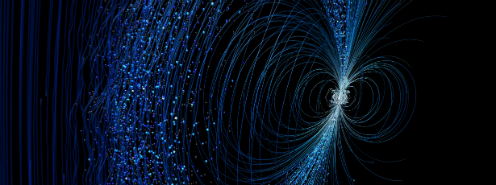Paper in Nature Physics: Recreating a comet in the lab

Laboratory bow shock generated in magnetised plasma-obstacle interaction excites plasma waves, leading to electron acceleration (Credits: F. Cruz & L.O. Silva, IST Lisbon). Click for full size.
The mystery of X-ray emission from comets has been solved by a laboratory experiment led by researchers at Oxford University, with collaborators at 14 other institutions, including NBIA’s Niels Bohr Professor Subir Sarkar. The paper is published in Nature Physics (2018).
It has long been a mystery how comets can radiate X-rays, given that such emission is usually associated with hot objects like the Sun, while comets are among the coldest objects in the Solar System. The X-rays are observed from the Sun-ward side of the comet where the Solar wind impacts the cometary atmosphere, forming a bow shock. The team used the LULI laser facility at Ecole Polytechnique in Paris to replicate the interaction of the Solar wind with a comet. Laser beams were fired onto a plastic foil which explodes, causing a stream of electrons and ions to be expelled forming a high speed flow of ionised gas (plasma) like the Solar wind. When this flow impacts onto a solid sphere - the laboratory ‘comet’, placed about 1 cm away from the plastic foil - it resembles what happens when a real comet passes through the Solar system. It was found that electrons are heated up to about a million degrees in the up-stream region by plasma turbulence. These hot electrons can then emit X-rays in the presence of a magnetic field.
This work also sheds light on a long standing cosmic mystery: how high energy particles are accelerated in Nature. This latest experiment clearly demonstrates that plasma turbulence can provide the initial source of fast particles in, for example, supernova shock waves which are believed to be the sources of galactic cosmic rays.
A copy of the paper is available at: doi:10.1038/s41567-018-0059-2
